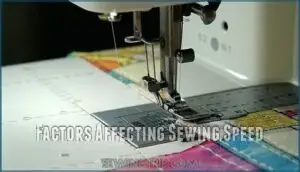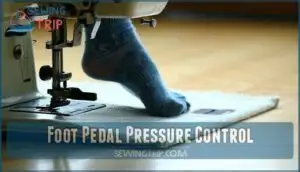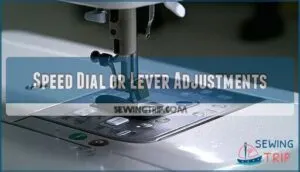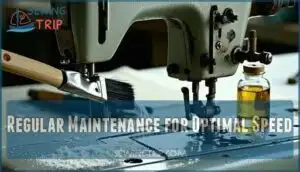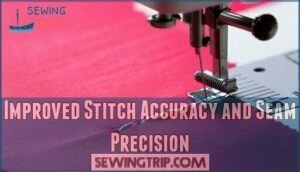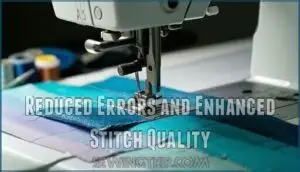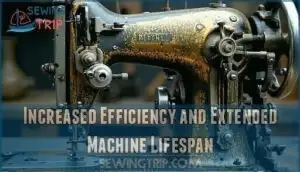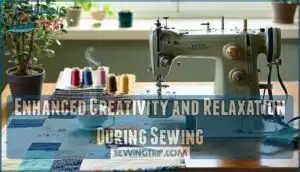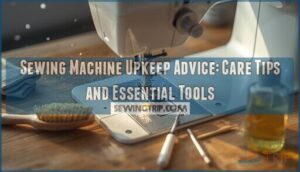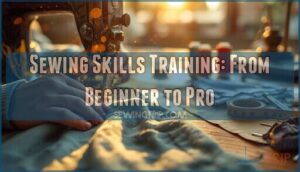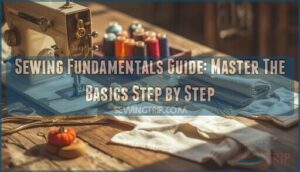This site is supported by our readers. We may earn a commission, at no cost to you, if you purchase through links.
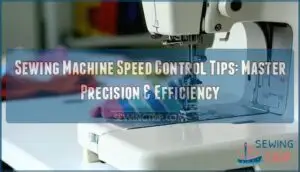 Mastering sewing machine speed control tips starts with understanding your foot pedal pressure.
Mastering sewing machine speed control tips starts with understanding your foot pedal pressure.
Light pressure equals slow stitching, while heavy pressure speeds things up.
Most machines also have speed limit dials that cap your maximum speed, perfect for beginners or delicate fabrics.
If you’re working with thick materials, slower speeds prevent needle breaks and thread tangles.
For straight seams, you can go faster, but curves and corners need patience.
Don’t forget your machine’s maintenance – clean motors run smoother and respond better to speed changes.
The secret lies in matching your speed to both your skill level and project requirements.
Table Of Contents
- Key Takeaways
- Sewing Machine Speed Basics
- Factors Affecting Sewing Speed
- Top 9 Sewing Speed Control Accessories
- 1. Black Pre Wound Embroidery Bobbins Thread
- 2. Amazon Basics Adjustable Drafting Stool
- 3. White Prewound Bobbin Thread Size A
- 4. Babylock Brother Blind Hem Presser Foot
- 5. Office Chair Mat for Carpet
- 6. Prewound Bobbins Assorted Colors Sewing Thread
- 7. Janome Blind Hem Foot Attachment
- 8. Brother SA133 Blind Stitch Foot
- 9. Low Shank Binder Sewing Foot
- Adjusting Sewing Machine Speed
- Benefits of Controlled Sewing Speed
- Frequently Asked Questions (FAQs)
- Conclusion
Key Takeaways
- You’ll achieve better stitch quality by matching your foot pedal pressure to the project – light pressure for delicate fabrics and detailed work, firm pressure for straight seams on sturdy materials.
- Use your machine’s speed limit dial to set maximum speeds that prevent rushing, especially when you’re learning new techniques or working with challenging fabrics like silk or leather.
- Regular maintenance keeps your speed control responsive – clean lint buildup, oil moving parts every 8-10 hours of use, and check belt tension for consistent performance.
- Slow down for curves, corners, and thick seams to prevent needle breaks and thread tangles, then speed up on straight sections where precision matters less than efficiency, and always consider the project and fabric type.
Sewing Machine Speed Basics
You’ll find that controlling your sewing machine’s speed is the key to achieving professional-looking results and avoiding costly mistakes.
Master your machine’s tempo – speed control separates amateur stitching from professional craftsmanship.
Whether you’re working with a manual machine that relies on handwheel control or an electric model with a foot pedal, mastering speed control transforms your sewing experience from frustrating to enjoyable.
Manual Speed Control Methods
Manual speed control methods require mastering your handwheel technique and understanding belt tension basics.
You’re the engine that drives consistent rhythm, making mechanical knowledge essential for smooth sewing.
- Handwheel Technique: Turn the handwheel steadily with your dominant hand while guiding fabric with the other
- Belt Tension: Check that your belt isn’t too loose (sluggish operation) or too tight (difficult turning)
- Rhythm Consistency: Develop a steady pace through practice – think metronome, not race car
- Mechanical Knowledge: Learn your machine’s moving parts to troubleshoot speed issues effectively
- Manual Machine Maintenance: Regular oiling and cleaning keep your speed control smooth and predictable
Electric Speed Control Methods
Electric sewing machines give you precise control through the foot pedal – light pressure for slow, deliberate stitches, firm pressure for faster speeds.
Digital interfaces on modern machines display exact speed settings, while servo motors provide variable control from 500-3,500rpm.
Electronic speed control systems with motor speed adjustment let you fine-tune performance beyond basic pedal pressure, ensuring consistent results across different fabric types with variable control.
Advanced Digital Regulation Systems
Today’s digital regulation systems transform your sewing machine into a precision instrument.
These advanced motor speed adjustment features use sensor integration for automatic adjustment based on fabric thickness and stitch requirements. Motor calibration maintains consistent performance, while programmable speeds let you save custom electronic settings. Digital displays show exact speed measurements for complete control.
These advancements are part of <strong>AI integration</strong> in modern sewing machines.
- Sensor Integration – Automatically detects fabric density and adjusts speed accordingly
- Motor Calibration – Maintains precise RPM under varying load conditions
- Programmable Speeds – Store custom speed profiles for different projects
- Digital Display – Shows real-time speed measurements and settings
Factors Affecting Sewing Speed
Understanding what affects your sewing machine’s speed helps you choose the right settings for each project.
Several key factors determine how fast or slow you should sew for the best results.
Fabric Density and Thread Type
Your fabric density and thread type directly impact your sewing speed control settings.
Heavy fabrics like denim require slower speeds to prevent needle damage, while lightweight cotton handles faster speeds beautifully.
Delicate threads need gentle handling at reduced speeds, whereas heavy-duty threads tolerate higher speeds.
Always match your ideal speed to fabric weight and thread compatibility for perfect results.
Needle Size and Stitch Length
How does needle compatibility with fabric thickness affect your sewing speed control? Choosing the right combination guarantees smooth stitching and prevents machine strain.
- Needle Compatibility: Match needle size to fabric type – universal needles for cottons, ballpoint for knits, leather needles for heavy materials
- Fabric Thickness: Larger needles penetrate thick fabrics easier, allowing consistent sewing speed without motor stress
- Thread Matching: Coordinate thread weight with needle eye size to prevent breakage and maintain stitch consistency
- Stitch Appearance: Proper needle-to-stitch length ratio creates even seams and professional-looking results
- Seam Strength: Balanced combinations enhance durability while maintaining peak sewing speed control
Machine Type and Condition
When evaluating your sewing machine’s performance, both machine type and mechanical condition directly impact your stitching speed and overall results. Industrial machines achieve up to 1,500 stitches per minute, while domestic models typically reach 650-1,100spm, making machine selection essential for your projects.
| Machine Type | Speed Range (SPM) | Common Issues | Maintenance Needs |
|---|---|---|---|
| Industrial | 1,200-1,500 | Motor wear, gear damage | Heavy-duty lubrication |
| Heavy-duty Domestic | 800-1,100 | Belt slippage, needle alignment | Regular maintenance schedule |
| Standard Electric | 650-900 | Thread jamming, tension problems | Monthly cleaning, oiling |
| Manual | Variable | Belt tension, handwheel stiffness | Periodic belt adjustment |
Your electric sewing machine’s condition affects speed consistency more than you might expect. Manual sewing machines require proper belt tension and regular maintenance to prevent sluggish operation. For more complex projects, consider computerized sewing machines that offer advanced features. Watch for motor wear signs like unusual noise or reduced power, and address gear damage promptly.
Proper needle alignment prevents thread breaks that slow your work. Regular sewing machine maintenance and timely sewing machine repair keep your equipment running at peak performance, whether you’re using industrial or domestic models.
Top 9 Sewing Speed Control Accessories
The right accessories can transform your sewing experience by giving you better control over machine speed and stitch quality.
You’ll find that simple additions like ergonomic seating, proper foot positioning, and quality threads work together to help you maintain consistent speeds and achieve professional results.
1. Black Pre Wound Embroidery Bobbins Thread
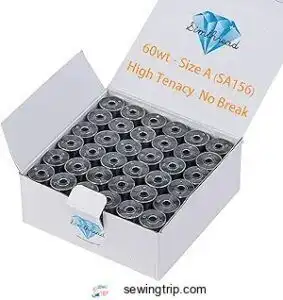
These game-changing bobbins transform your sewing experience by eliminating the tedious winding process.
Game-changing thread management that keeps your machine running smoothly without constant bobbin breaks.
You’ll save precious time with 144 pre-wound black polyester bobbins that deliver consistent tension and smooth stitching.
The high-tenacity 70D filament reduces friction and static, letting you maintain steady speeds without thread breaks.
Compatible with Brother, Janome, Singer, and most home machines, they’re perfect for dark fabrics where bobbin thread might show through.
Each bobbin contains over 128 inches of premium thread that won’t distort or absorb machine oils, keeping your speed control consistent throughout long projects, ensuring a smooth experience with high-tenacity filament.
Best For: Busy crafters and embroidery enthusiasts who want high-quality, ready-to-use black bobbins for dark fabrics without the hassle of manual winding.
- Not compatible with every machine (e.g., Ricoma EM-1010).
- Each bobbin has limited thread (128 inches), requiring replacements during larger projects.
- Fit issues may occur if machine specifications are not checked before purchase.
- Saves significant time with 144 pre-wound bobbins, eliminating manual winding.
- Consistent, high-tenacity polyester thread ensures smooth stitching and minimal breakage.
- Fits most popular home and commercial sewing machines, making it widely compatible.
2. Amazon Basics Adjustable Drafting Stool
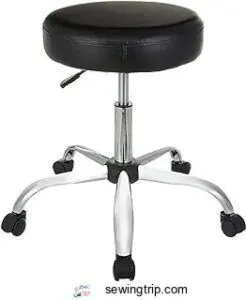
Second to good thread management, your seating makes all the difference when controlling sewing speed.
The Amazon Basics Adjustable Drafting Stool transforms your workspace by positioning you at the perfect height for steady hand control.
Its 20.3 to 34-inch height range lets you align with any sewing table, while the 360-degree swivel keeps you fluid around your machine.
The pneumatic adjustment means quick changes between projects, and dual-wheel casters let you glide smoothly without jarring movements that mess up delicate stitching, allowing for steady hand control.
Best For: Sewists and crafters who need adjustable, ergonomic seating for multi-station or high work surfaces.
- Wide height range and foot ring suit various tables and reduce body strain.
- Smooth swivel and casters enhance mobility and workspace efficiency.
- Easy to assemble, affordable, and low-maintenance design.
- Slippery seat surface requires caution and may affect comfort.
- Backrest is stationary, offering limited reclining support.
- Maximum seat height may still be too high or low for some users.
3. White Prewound Bobbin Thread Size A
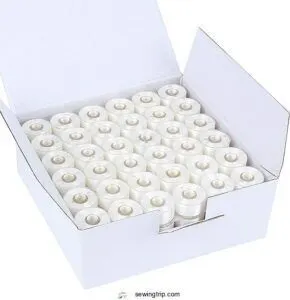
For consistent speed control, white prewound bobbin thread delivers uniform tension that keeps your machine humming smoothly.
These Size A bobbins fit most Brother, Singer, and Janome machines, holding 110-145 yards of 60WT polyester thread.
You’ll notice fewer skipped stitches and tension issues compared to hand-wound bobbins.
The factory-wound consistency means you can maintain higher speeds without worrying about thread breaks or bird’s nests, and spend less time rewinding bobbins and more time actually sewing your projects with higher speeds.
Best For: Home and commercial sewists who want to speed up quilting or embroidery projects with reliable, ready-to-use Size A bobbins.
- Not compatible with machines that require L-sized or non-standard bobbins
- Quality of plastic bobbin and thread may vary, especially with budget brands
- Occasional tension or top-showing thread issues may require minor adjustments
- Prewound for uniform tension and consistent stitch quality at higher speeds
- Fits most Brother, Singer, and Janome machines with proper size and weight
- Saves time on rewinding, allowing longer sewing sessions without interruption
4. Babylock Brother Blind Hem Presser Foot
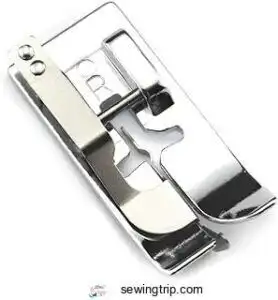
When speed matters, this presser foot becomes your hemming hero.
The Babylock Brother Blind Hem Presser Foot features an adjustable guide that maintains consistent spacing while you work at higher speeds.
Its snap-on design lets you switch between tasks quickly, and the metallic tongue prevents fabric distortion even during rapid sewing.
You’ll create professional, nearly invisible hems on pants, curtains, and garments without sacrificing accuracy for speed.
The center guide controls thread slack automatically, so you can focus on maintaining steady rhythm.
Compatible with numerous Babylock and Brother models, it’s built for durability and precision.
Best For: Home sewists and professionals using compatible Babylock or Brother machines who want quick, invisible hems with minimal fuss.
- Not compatible with all sewing machine brands or models; checking fit is required.
- May bend or break if handled roughly or used with thick materials.
- Users report variable fitting and performance, especially with non-listed machines like Singer.
- Adjustable guide ensures even, professional hems at any sewing speed.
- Snap-on design allows fast attachment and easy switching between tasks.
- Durable metal construction with automatic thread slack control prevents puckering and keeps stitches flat.
5. Office Chair Mat for Carpet
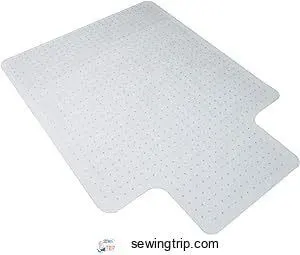
Stability transforms your sewing workspace when you’re fighting wobbly chairs on carpet.
This office chair mat creates a smooth surface that lets you roll effortlessly between your machine and cutting table without getting stuck.
The anti-skid top and gripping studs keep it locked in place on thick carpet, while ramped edges prevent catching.
You’ll maintain better posture and control during long sewing sessions, reducing strain that can throw off your precision stitching rhythm and speed adjustments.
Best For: Users with standard or thick carpet who need smooth chair mobility and improved ergonomics in sewing or office spaces.
- Prevents chair from sinking or getting stuck, making movement easier and reducing strain.
- Anti-skid surface and cleats keep the mat stable during heavy use.
- Protects carpet from stains, caster marks, and long-term wear.
- Can be difficult to flatten out when unboxed, requiring patience and weights.
- Smaller size limits rolling space, which may restrict movement.
- Not suitable for hard floors or deep-pile carpets.
6. Prewound Bobbins Assorted Colors Sewing Thread

Time-saving thread warriors know that prewound bobbins in assorted colors eliminate workflow interruptions during complex projects.
You’ll avoid constantly stopping to wind bobbins when switching between thread colors, maintaining steady sewing momentum.
These factory-wound bobbins hold 30-50% more thread than self-wound versions, reducing bobbin changes mid-seam.
The consistent tension prevents skipped stitches and thread jams that can derail your rhythm.
Understanding the different bobbin types is vital for superior sewing machine performance.
With up to 36 different shades available, you’ll match any fabric combination while keeping your sewing speed steady and controlled throughout multi-colored projects.
Best For: DIY sewers, hobbyists, and busy crafters who need a wide range of thread colors ready to use straight from the box.
- Some users report occasional thread breakage during sewing.
- Bobbins may crack if dropped and need careful handling.
- Limited shade selection may not cover all specialized color needs.
- Saves time by eliminating the need to wind bobbins yourself.
- Wide variety of thread colors matches nearly any fabric or project.
- Consistent factory winding ensures smooth, reliable stitching and fewer thread jams.
7. Janome Blind Hem Foot Attachment
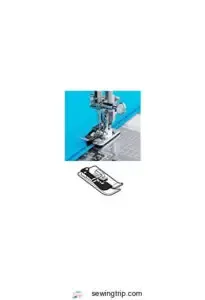
Janome’s blind hem foot transforms challenging hemming tasks into manageable projects.
You’ll notice the metal guide creates consistent fabric positioning while three grooves prevent slipping during stitching.
The foot’s design allows your needle to swing over the guide, creating necessary slack for nearly invisible hems.
This attachment works smoothly at various speeds, maintaining stitch quality whether you’re moving fast through straight sections or slowing down for corners.
Compatible with most Janome models, it snaps on quickly and supports both lightweight cottons and heavier fabrics like denim.
Best For: Home sewists and professionals looking for easy, near-invisible hems on a wide range of Janome sewing machines.
- Compatibility is limited and requires checking your machine model before purchase.
- Some users report inconsistent results, often tied to fabric choice or folding technique.
- May not fit Janome Memory Craft 9900, S7, or other unsupported models.
- Simple snap-on design suits many Janome models and makes setup quick.
- Built-in guide and grooves ensure accurate, slip-free hemming even on different fabrics.
- Enables fast, professional-looking hems without hand-sewing.
8. Brother SA133 Blind Stitch Foot
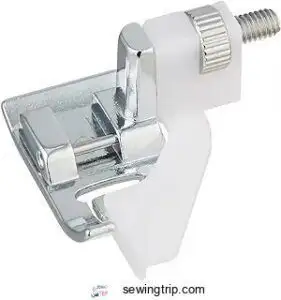
In the pursuit of perfecting your blind hems, the Brother SA133 Blind Stitch Foot becomes your secret weapon for achieving professional results at any sewing speed.
This adjustable presser foot features a guide that keeps fabric edges positioned precisely, allowing you to maintain consistent stitch quality whether you’re moving at a snail’s pace or cruising at higher speeds.
You’ll find that the foot’s open-toed design improves visibility during intricate work, while its compatibility with multiple Brother machine models makes it a versatile addition to your sewing arsenal for speed-controlled precision stitching with consistent stitch quality.
Best For: Home sewists and hobbyists looking to create nearly invisible hems and precise edge stitching on most Brother sewing machines.
- Instruction manual is lacking; beginners may need to rely on online tutorials and trial and error
- Some users report durability issues, with parts occasionally coming loose during use
- Requires careful adjustment and practice to avoid skipped stitches or visible bites, especially at higher speeds
- Delivers professional-looking blind hems and consistent edge finishes on various fabrics
- Adjustable guide and open-toe design improve control and stitch visibility, even at higher speeds
- Compatible with a wide range of Brother models, supporting both utility and decorative stitches
9. Low Shank Binder Sewing Foot
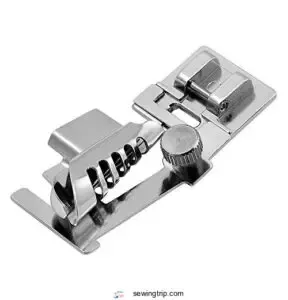
Through the magic of proper binding application, your Low Shank Binder Sewing Foot transforms tedious edge-finishing into smooth sailing.
This plastic foot folds and feeds bias tape automatically, eliminating pre-folding hassles while creating professional 1/4" bindings from 1" fabric strips.
You’ll maintain better speed control since the integrated funnel guides everything precisely, reducing stops and starts.
Compatible with most low-shank machines from Singer, Brother, and other major brands, it’s perfect for quilts and garments when you need consistent results at moderate speeds, making it a great tool for achieving professional results.
Best For: Beginners and hobbyists using low-shank sewing machines who want fast, professional-looking bias binding on quilts and garments.
- Not suitable for thick quilts or heavy fabric layers.
- No instructions included; requires online tutorials or practice.
- Challenging to use with non-standard or wider binding sizes.
- Folds and feeds bias tape in one step for clean, professional edges.
- Compatible with most major low-shank sewing machines.
- Saves time and eliminates pre-ironing or clipping binding strips.
Adjusting Sewing Machine Speed
You can fine-tune your sewing machine’s speed through several control methods that work together to give you precise control over every stitch.
Whether you’re working with delicate silks or heavy denim, mastering these adjustment techniques will transform your sewing from rushed and uneven to smooth and professional.
Foot Pedal Pressure Control
Your sewing machine pedal responds like a car’s gas pedal—light pressure equals slow, steady stitches, while firm pressure speeds things up.
Proper pedal placement and consistent pressure prevent foot fatigue while maintaining speed consistency. Practice pedal sensitivity adjustments to develop smooth foot pedal control. A replacement can enhance your pedal’s responsiveness.
- Position your foot comfortably on the pedal’s center for better control and reduced strain during long projects
- Apply gradual pressure rather than sudden movements to maintain consistent stitching speed and avoid jerky fabric feeding
- Practice on scrap fabric to develop muscle memory for different pressure levels and improve your foot pedal pressure technique
Speed Dial or Lever Adjustments
Want more precise control beyond your foot pedal? Your speed dial or sewing machine lever gives you consistent results every time.
Most machines place these controls on the front panel for easy access. Turn the speed dial clockwise for faster speed increments, counterclockwise for slower settings.
Lever mechanics work similarly—push forward to increase, pull back to decrease. Dial calibration guarantees your speed settings match your project needs, while adjusting sensitivity helps fine-tune control placement for comfortable operation.
Servo motors offer variable speed control for advanced adjustments, providing variable speed and advanced adjustments for optimal sewing experience.
Digital Speed Control and Motor Calibration
Digital speed control revolutionizes your sewing experience through programmable speeds and sensor integration.
Modern machines feature digital displays with speed dial presets, allowing precise motor speed adjustment. Motor calibration guarantees automatic adjustment based on fabric thickness, while digital calibration fine-tunes your sewing machine motor for consistent performance.
Consider buying speed control products for your sewing needs. Motor precision becomes effortless with these advanced systems and digital displays, providing a seamless sewing experience with automatic adjustment.
Regular Maintenance for Optimal Speed
Keep your machine humming by sticking to a regular sewing machine maintenance routine.
Cleaning lint after each project, checking needle condition, and inspecting the belt help with smooth sewing machine speed control.
Oiling frequency matters—apply sewing machine lubrication every 8–10 hours. Proper maintenance requires using the correct type of lubricant.
Don’t skip motor servicing or professional sewing machine repair when needed. Quick troubleshooting avoids slowdowns and keeps your stitches sharp.
Benefits of Controlled Sewing Speed
When you control your sewing speed, you’ll see immediate improvements in stitch quality and overall project results.
Proper speed management helps you avoid costly mistakes while extending your machine’s life and making sewing more enjoyable.
Improved Stitch Accuracy and Seam Precision
When you master sewing speed control, your stitch quality transforms dramatically.
Controlled speeds let you handle fabric with precision, maintaining proper tension control while traversing complex patterns and intricate details.
Consistent stitching becomes your signature, delivering professional sewing accuracy in every project.
- Precise needle placement – Slower speeds give you pinpoint control over where each stitch lands
- Even seam lines – Consistent sewing speed prevents wobbly or uneven stitching patterns
- Better fabric handling – Controlled pace lets you guide material smoothly through tricky curves
- Professional finish – Precision work at ideal speeds creates clean, lasting seams every time
Reduced Errors and Enhanced Stitch Quality
Controlled speed prevents common mistakes like skipped stitches and uneven seams. You’ll notice better Fabric Handling when you maintain consistent sewing speed, giving you time to guide material smoothly.
Understanding mechanical speed adjustments is key to mastering control. This Tension Control creates Professional Results every time.
| Speed Issue | Solution |
|---|---|
| Rushing causes puckering | Slow down for even feed |
| Fast corners create bulk | Reduce speed at turns |
| Thick seams skip stitches | Lower speed prevents damage |
Consistent Stitching comes from matching your pace to the project’s needs, improving sewing accuracy naturally.
Increased Efficiency and Extended Machine Lifespan
When you maintain proper settings and ideal lubrication, your machine runs like a well-oiled clock.
Consistent stitching prevents reduced rework, saving precious time on projects.
Motor maintenance through sewing machine speed optimization keeps your equipment humming for years.
Smart sewing machine efficiency habits protect your investment while delivering professional results every stitch.
Enhanced Creativity and Relaxation During Sewing
Beyond efficiency gains, you’ll discover that controlled sewing speed opens doors to artistic expression and stress reduction.
Mindful stitching at a slow sewing speed transforms your workspace into a peaceful sanctuary where creative flow flourishes naturally.
- Mindful Stitching – Focus on each stitch creates a meditative experience that calms your mind
- Creative Flow – Slower speeds allow time to experiment with techniques and explore new creative possibilities
- Stress Reduction – Gentle rhythm reduces tension and promotes relaxation during long sewing sessions
- Project Enjoyment – Taking time enhances satisfaction and connection with your handmade creations
- Artistic Expression – Benefits of slow sewing speed include freedom to add intricate details and personal touches
Frequently Asked Questions (FAQs)
What controls how fast the machine sews?
Like a conductor’s baton directing an orchestra, your foot pedal pressure controls the tempo. Light pressure creates slow, deliberate stitches, while firm pressure speeds things up for straight seams.
What determines the speed of the sewing machine?
You set the sewing machine’s speed using the foot pedal, a speed dial, or sometimes a digital control.
Fabric thickness, thread type, needle size, and even belt tension can all play a part in how fast you sew.
How do I fix inconsistent stitching speeds?
Check your foot pedal connection, clean and oil your machine, adjust thread tension properly, and verify the belt isn’t worn or loose for consistent stitching speeds.
Why does my machine slow down unexpectedly?
Your machine likely slows down due to thick fabric resistance, low foot pedal pressure, loose belt tension, or motor strain.
Check fabric thickness, increase pedal pressure, and make certain proper lubrication for consistent speed.
Can I retrofit speed control on older machines?
While you’d love an instant upgrade, yes – retrofitting speed control on older machines is possible.
You can add external foot pedals with speed regulation, install variable speed motors, or use servo motor kits for precise control.
What causes foot pedal sensitivity issues?
Foot pedal sensitivity problems stem from worn internal components, dirty contacts, faulty wiring connections, or incorrect calibration settings that disrupt the electrical signal controlling your machine’s motor speed.
How do I calibrate digital speed settings?
Fine-tuning your digital speed control is like tuning a piano – small adjustments create perfect harmony.
Access your machine’s menu, navigate to speed settings, then adjust the maximum speed limit and pedal sensitivity to match your preferred sewing pace, creating a perfect harmony between your sewing style and the machine’s capabilities.
Conclusion
Like a master conductor orchestrating a symphony, mastering these sewing machine speed control tips transforms your stitching from chaotic to graceful.
You’ll find that proper foot pedal pressure, speed dial adjustments, and regular maintenance create the perfect rhythm for any project.
When you match your speed to fabric type and skill level, you’ll experience fewer mistakes and smoother seams.
Remember, controlled speed isn’t about going slow—it’s about going smart, giving you confidence to tackle everything from delicate silk to heavy denim with precision.
- https://patents.google.com/patent/US4386301A/en
- https://www.topeaglesewing.com/info/a-look-at-the-trends-in-intelligent-sewing-tec-88170989.html
- https://www.anysew.com/application/servo-sewing-machine
- https://www.mynecchi.com/products_detail/331.htm
- https://apparelresources.com/technology-news/manufacturing-tech/digital-feed-in-sewing-machine-a-fad-or-a-useful-feature/

